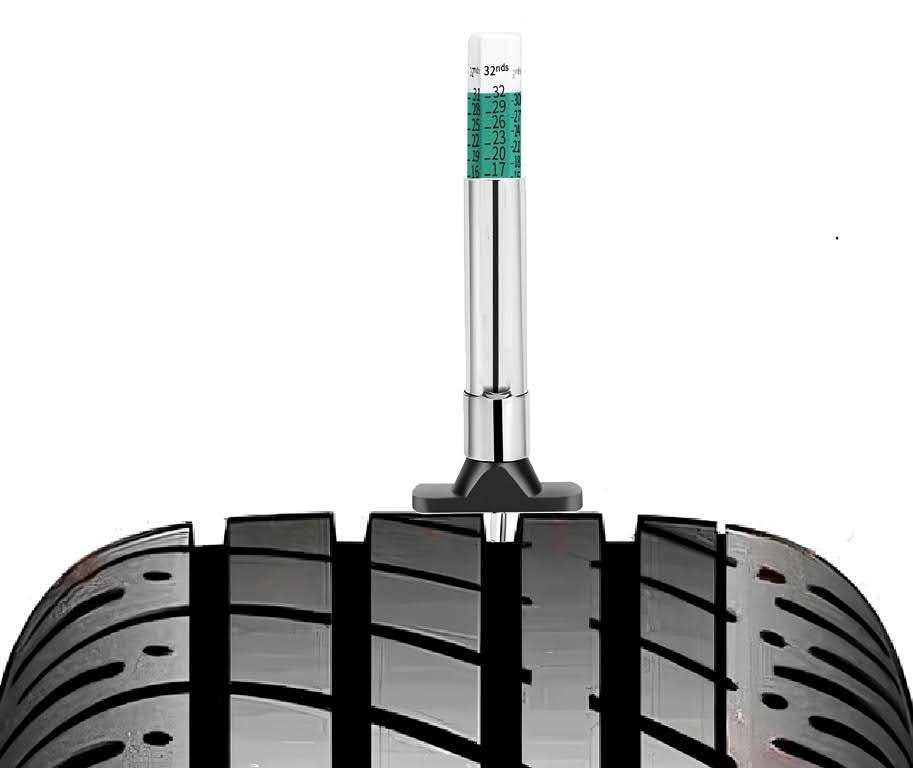As the contact point between your vehicle and the ground, your tires should always be in good condition. Over time, however, tires will naturally wear and lose their tread depth, which is what gives your tires their grip. When its tread depth gets too thin, the tire loses grip, affecting braking distance and handling. Luckily, you can make sure your vehicle’s tire tread depth never gets to that point by regularly measuring it with a tread depth gauge.
What Is a Tire Tread Depth Gauge?
As its name suggests, a tire tread depth gauge is a tool used to measure a tire’s tread depth. Tire tread depth gauges come in different designs, with some equipped with a dial for easier reading. You can also find digital tire tread depth gauges with a large LCD screen that displays the tread depth rating.

How To Use a Tire Tread Depth Gauge
Using a tire tread depth gauge can be a little confusing at first, but it gets easier once you understand the basics. Here are helpful tips on how to use a tread depth gauge:
Zero Out the Tread Depth Gauge
Before you insert the gauge into the groove, you’ll have to zero it out first. Push the tread depth gauge against a flat surface until the measuring pin slips into the barrel. If the gauge reads 0/32, then you can now move on to the next step.
Place the Measuring Pin Into the Tread Groove

Check the Tread Depth Reading
Carefully remove the gauge, and note the measurement indicated on the gauge. Keep your hands on the barrel, so you don’t accidentally touch the measuring pin.
Repeat the Process Two More Times
One reading isn’t going to be enough to truly get an accurate measurement of your vehicle’s tire tread depth. Uneven treadwear is common among misaligned wheels, so it’s best to repeat the first three steps at least two more times. Insert the measuring pin at different points of the tread groove, with around 15 inches in between each point.
Compute for the Average Tire Tread Depth
To get the average tread depth, add all three of your readings, and divide the total by three. The answer is the average tire tread depth, which you can now compare to the tire’s original specs.
Why Is Measuring Tire Tread Depth Important?
In most US states, the minimum legal tire tread depth of passenger cars is 2/32 of an inch. This can still vary, depending on where you live and the type of vehicle you drive. For example, most states will require larger vehicles such as buses and trucks to have a tread depth of at least 4/32 of an inch.
Non-commercial vehicles aren’t required to have safety or tire tread inspections in most states. Texas is dropping that requirement in January of 2025. If your state requires safety inspections, you’ll know it, because you’ll be ticketed if your vehicle hasn’t been inspected for that year.
For your own safety, it’s best to inspect your tires regularly, so you can replace them before it’s too late. Keep in mind that worn-out tires are dangerous.
How Much Does a Tread Depth Gauge Cost?
Tread depth gauges are relatively affordable, with some selling for as cheap as $10. However, if you’re looking for a branded, high-quality gauge, then you might have to shell out around $260.
How To Gauge Tire Tread Depth
Using a tire tread depth gauge isn’t the only way you can measure your tire’s tread depth. In fact, there are several other methods you can try, just in case you forget your gauge at home.
Perform a Penny Test
The most popular method is performing a penny test, where you insert a penny into your tire’s tread groove. With Lincoln’s head upside down and facing you, check to see how much of his head is exposed. If you can see all of his head, then this means you need to replace your tires as soon as possible.
Use a Quarter
If you’re out of pennies, you can use a quarter too. Insert the coin into the tread groove, and check if the tread is touching Washington’s head. If Washington’s head is exposed, then your tires need replacing.
Check the Tire Tread Wear Indicator
Printed around the bottom of the tread groove, you’ll find the tire tread wear indicator. As the tread wears down, it’ll slowly become even with the indicator. Once this happens, it’s a sign that you need to replace your tires.
Keep Tire Tread In Good Shape With the Right Tire Pressure
One of the key symptoms of a tire with low tire pressure includes uneven tire wear, which can result in one of your tires losing its tread faster than the others. A good way to prevent this is to check tire pressure regularly with a tire pressure gauge. If you don’t have this handy tool, you can find and order one in just a few minutes when you shop online at CarParts.com.
At CarParts.com, we have an excellent selection of tire pressure gauges. We understand that quality is paramount when it comes to tools that play a critical role in maintaining your vehicle, so we only source our gauges from trusted aftermarket manufacturers. Need your gauge as soon as possible? Don’t worry, as we have strategically located warehouses around the country to guarantee fast shipping.
Keep your vehicle’s tires inflated with the right air pressure. Check out our tire pressure gauges and order one today!
Any information provided on this Website is for informational purposes only and is not intended to replace consultation with a professional mechanic. The accuracy and timeliness of the information may change from the time of publication.

































